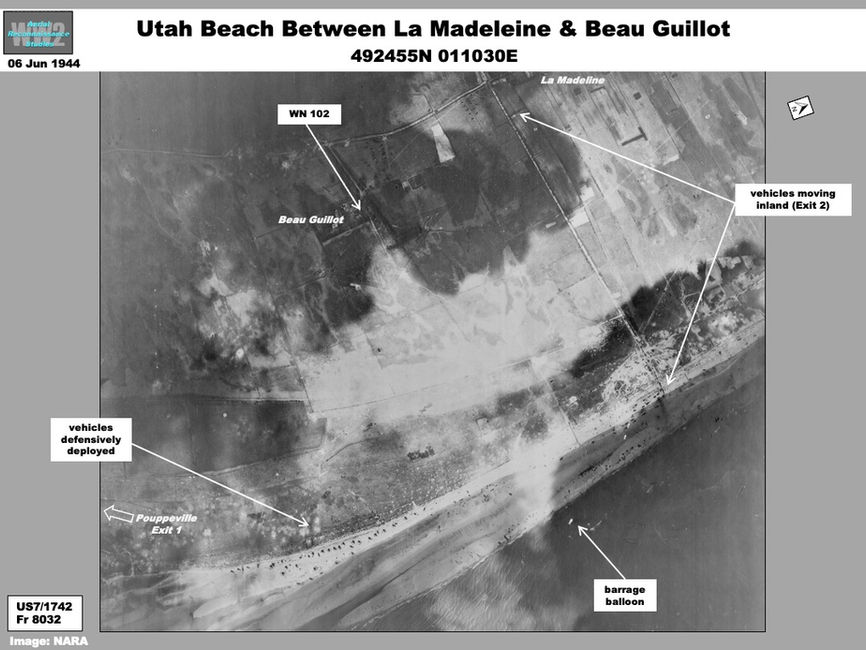WW2 AERIAL RECON STUDIES
Western Front
D-Day: Utah & Omaha Beaches
Little new can be added to the story of Utah and Omaha beaches, but a look at available imagery from 6 June 1944 offers some insight into the landings and beach conditions. Unfortunately, although numerous reconnaissance sorties attempted to image the beaches the coverage of was not continuous, making it difficult to depict action in a wide area.
Utah Beach
The 4th Infantry Division began landing at Utah at 06:30 with preparatory bombardment by ships and aircraft (05:50). The assault was conducted in four waves, with the intention of securing four exit causeways. A strong current pushed the landings southeast of their intended areas (Tare Green and Uncle Red), but defenses were neutralized and the beaches secured by 08:30. Somewhat later coverage showed units moving inland. Good coverage in the vicinity of Exit 2 from the same sortie showed equipment headed to La Madeline and another group of vehicles near Beau Guillot, 1700 meters southeast of Exit 2 (Graphics). The vehicles appeared defensively deployed along the seawall and beneath a German strongpoint (WN 102). Three barrage balloons could be seen over the beach.
Earlier coverage of Utah was possibly taken before the fourth landing wave hit the beach. The tidal flats and evidence of the pre-landing bombardment could still be near La Grande Dune and Beau Guillot (Graphic). A group of Sherman tanks on the beach outside La Grande Dune may have been from the third wave that actually landed ahead of amphibious DD tanks from the first wave (Graphic).
Omaha
Two infantry divisions --the 1st and 29th -- and a Ranger battalion landed at Omaha in two assault waves. The beach had had eight landing zones: Charlie, Dog Green, Dog White, Dog Red, Easy Green, Easy Red, Fox Green and Fox Red. The assault focused valleys (Draws D-3, E-1, E -3, and F-1) for access off beach. Rough seas, a rise called a shingle 200 meters from the beach and enemy fire hampered the assault and scattered the landing units (Graphic).
The earliest coverage appeared to catch the second assault wave in progress: elements of the 115th and 116th infantry Regiments (29th Infantry Division) and 5th Ranger Battalion were arriving at Dog White, while other elements of the 116th were on the beach at Easy Red (Graphics). The tidal flats and the shingle/shelf were more exposed. Later coverage of Easy Red and Easy Red near Les Moulins shows the beaches at high tide (Graphic).
The oblique cameras on the P-38/F-5 were useful in capturing the action offshore. Coverage taken off Easy Green and Easy Red beaches probably during the second landing wave revealed a very busy scene (Graphic). Landing craft were headed to and from the beaches and some vehicles could be seen swimming to shore over the shingle. Three warships that participated in the pre-invasion bombardment could be seen in the area.











